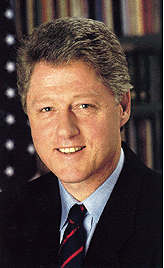The Impeachment of Bill Clinton
Bill Clinton was the second U.S. President to be impeached. This happened in 1998–1999. Article II, Section 4 of the U.S. Constitution reads thus: "The President, Vice President and all civil Officers of the United States, shall be removed from Office on Impeachment for, and Conviction of, Treason, Bribery, or other High Crimes and Misdemeanors."  In impeachment proceedings, the members of the House of Representatives serve in the role of a grand jury, deciding whether to bring an indictment against a particular individual. If a simple majority of the House votes for such an indictment, then the individual faces charges of impeachment. Such charges as referred to as Articles of Impeachment. The next step is a trial, and the people deciding the individual's guilty or innocence are the members of the U.S. Senate. The Chief Justice of the United States presides over an impeachment trial. If a two-thirds majority of the Senate votes to convict the individual facing impeachment, then the individual is convicted and removed from office. The Senate can further, by a simple majority, declare that the convicted individual can never again be eligible to hold public office. Andrew Johnson had been impeached in 1868 but had been acquitted by the Senate. A third President, Richard Nixon, resigned in the face of impeachment proceedings. Another President, John Tyler, was the target of impeachment proceedings with regard to the fiery debate over states' rights, but the full House did not approve the measure. 
Clinton had been the target of a harassment lawsuit filed by Paula Jones, who worked for the State of Arkansas when Clinton was Governor of that state. Jones filed the lawsuit in 1994, when Clinton was President. (He had been elected in 1992.) The U.S. Supreme Court had declared that Clinton, even as President, could legally be sued while he was in office. During the proceedings of the Jones lawsuit, allegations surfaced of inappropriate conduct with other women, one of whom was a White House intern, Monica Lewinsky. Clinton was already under investigation by Independent Counsel Ken Starr in regard to a number of allegations of improper use of federal power with regard to the use of FBI files, the firing of White House employees, and a real estate debacle that dated the 1980s known as Whitewater. Starr expended his investigation to include allegations of Clinton's relationship with Lewinsky and submitted his findings to Congress in a lengthy report. 
The House Judiciary Committee, because it had the Starr Report, did not conduct its own investigation. The full House on Dec. 19, 1998, voted to approve two Articles of Impeachment against Clinton. He was accused of lying to a grand jury and of engaging in obstruction of justice (with the allegation being that he had encouraged other people to lie about the nature of his relationship with Lewinsky). The U.S. Senate, with Chief Justice of the United States William Rehnquist presiding, took up the case, beginning on Jan. 7, 1999. On Feb. 12, the Senate voted on both Articles of Impeachment. In neither case did the "guilty" votes total 67 (the two-thirds of the 100-member Senate needed in order to "convict"). |
|
Social Studies for Kids
copyright 2002–2024
David White





